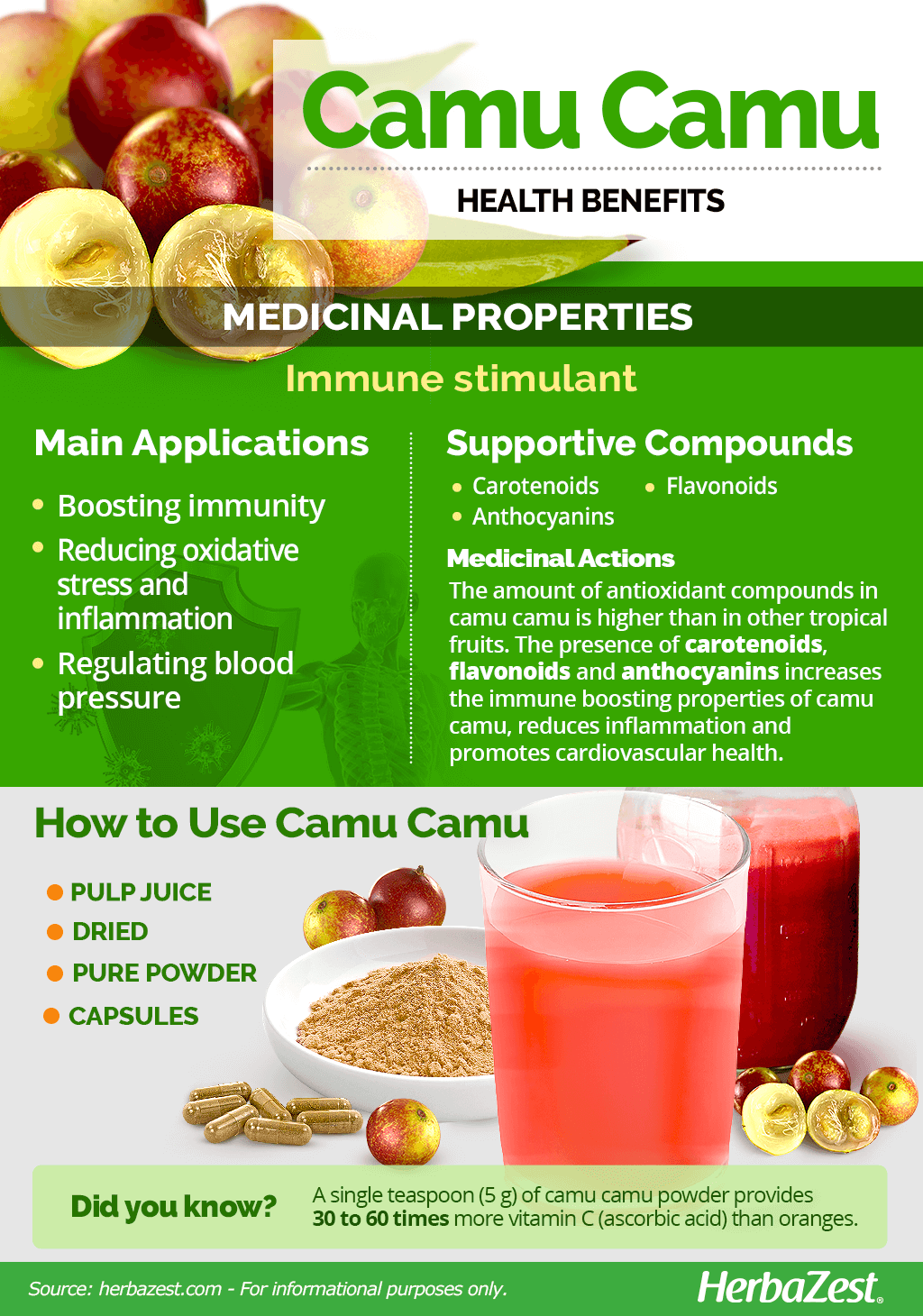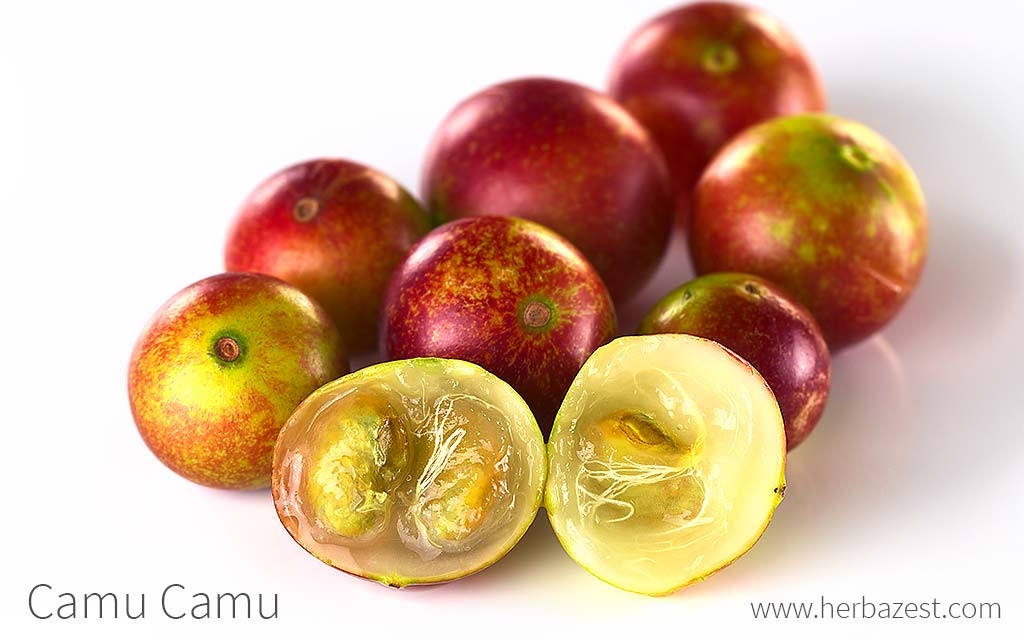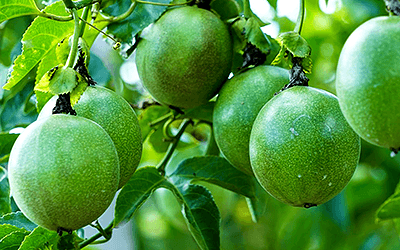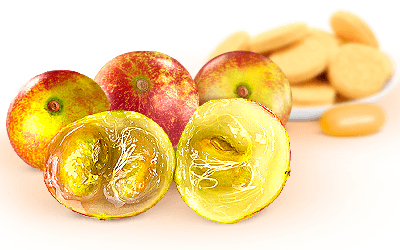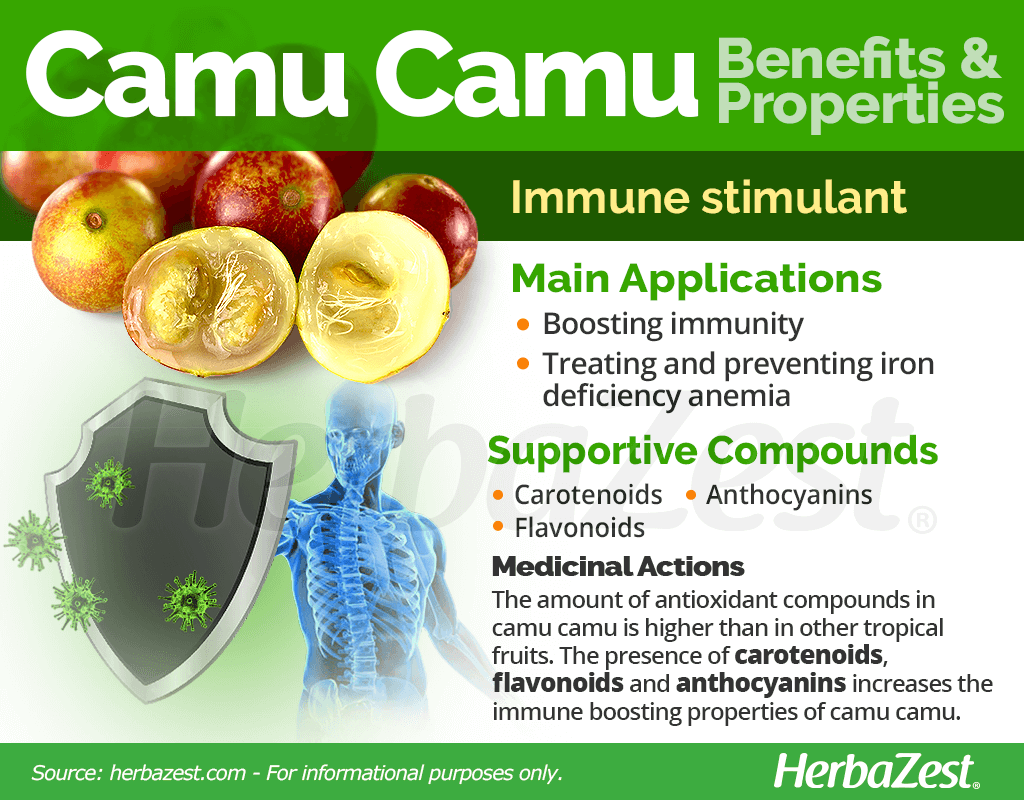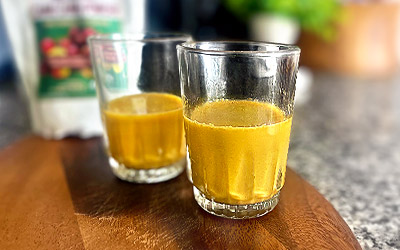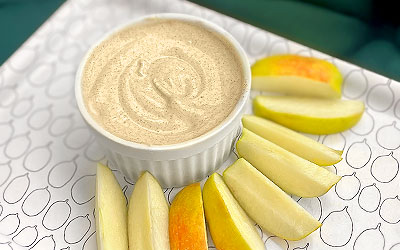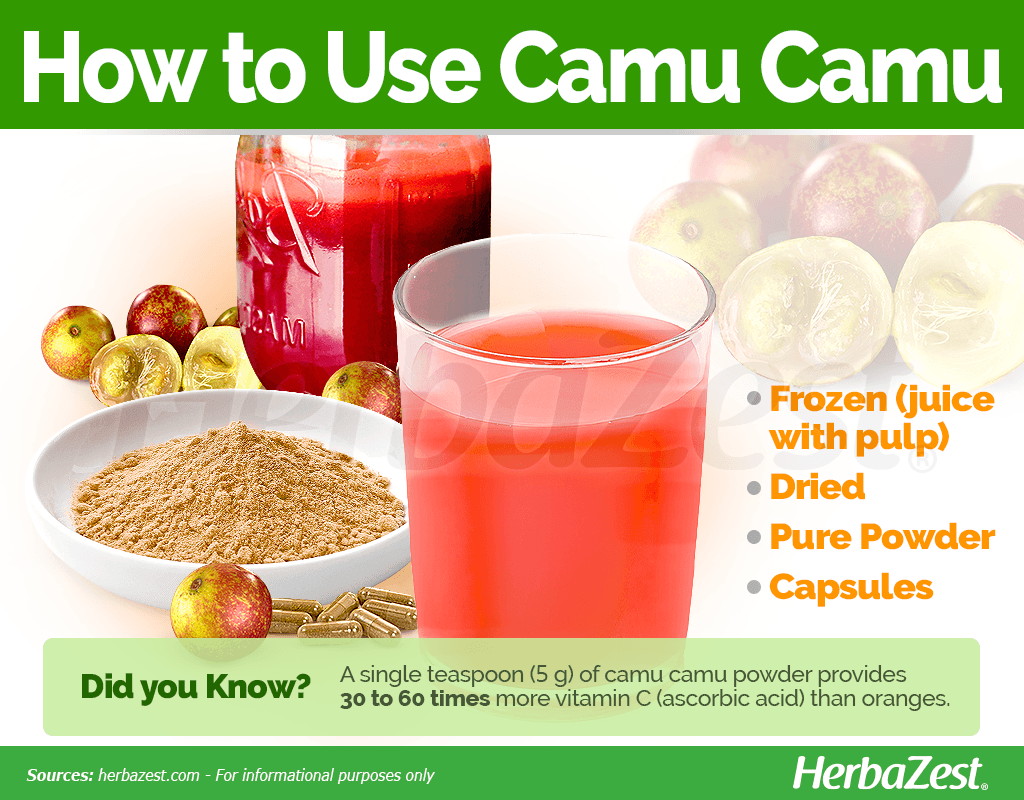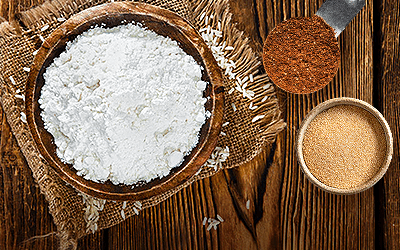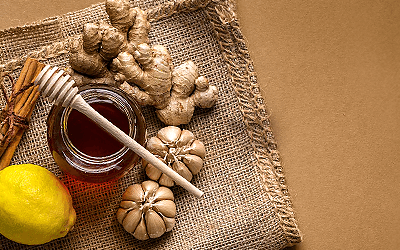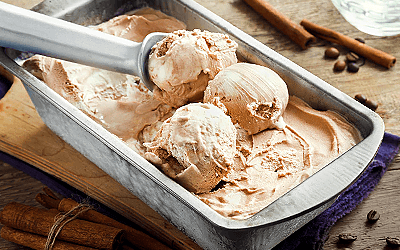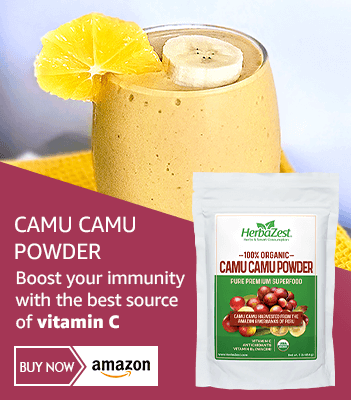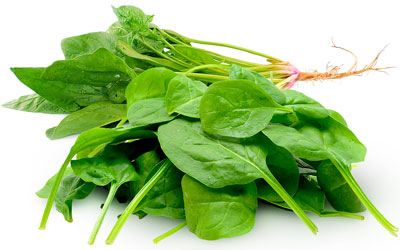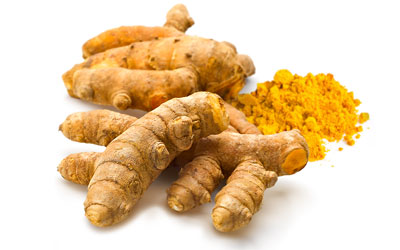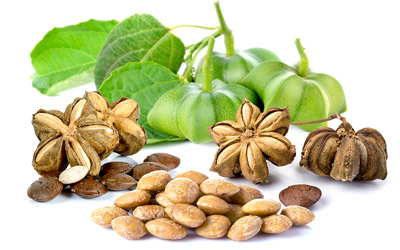First used by the indigenous peoples of the Amazonian region, camu camu was a source of food and herbal medicine for hundreds of years prior to its wider appreciation. Since camu camu's medicinal and nutritional potential was first investigated by the Peruvian government in the 1950s, the popularity of the tropical berry has been steadily growing, mainly due to its high vitamin C (ascorbic acid) content.
Camu Camu Medicinal Properties
Health Benefits of Camu Camu
The impressive amount of vitamin C (ascorbic acid) contained in camu camu has noticeable effects on overall health and provides the following benefits:
Boosting immunity. Research shows that the high amount of vitamin C in camu camu effectively strengthens the immune system, thus preventing viral infections as well as reducing their length and severity.
Reducing oxidative stress and inflammation. A study has found that camu camu's antioxidant and anti-inflammatory properties are more powerful than those of vitamin C supplements.1
Regulating blood pressure. Initial in vitro studies have suggested that camu camu has potent antihypertensive effects, thus offering cardiovascular benefits.2
Additionally, camu camu has proven useful for treating and preventing iron deficiency anemia and scurvy as well as for promoting healthy skin and nerves. Furthermore, ongoing research on camu camu health benefits suggests that it may be useful for relieving the pain of rheumatoid arthritis as well as for preventing liver damage.
How It Works
Camu camu contains important phenolic compounds, mainly carotenoids, flavonoids and anthocyanins, which greatly contribute to its antioxidant, immune stimulant effects. Its exceptional amount of vitamin C (ascorbic acid) boosts the immune system by increasing the absorption of iron and scavenging free radicals. Together, all these phytonutrients seem to be responsible for most camu camu properties.
The amount of antioxidant compounds in amazonian camu camu is higher than in other tropical fruits, and it is concentrated in the seeds and peel of the berry.
Camu Camu Side Effects
There are no known side effects associated with camu camu; yet, there is also a lack of scientifically validated research for the plant. It should be noted that due to the acidic nature of the plant, over-consumption could lead to heartburn or indigestion.
- Medicinal action Immunostimulant
- Key constituents Caroteoinds, flavonoids, anthocyanins, vitamin C (ascorbic acid)
- Ways to use Capsules, Food, Juiced, Powder, Dried
- Medicinal rating (1) Very minor uses
- Safety ranking Safe
Camu Camu Nutrition
Camu camu is the best known source of vitamin C (ascorbic acid). A single teaspoon (5 mg) of organic camu camu powder amply exceeds the recommendation of 90 mg/day for adult men and 75 mg/day for adult women. It also surpasses the amount of ascorbic acid in orange (2 mg/tsp) and kiwi (4 mg/tsp). This extraordinary concentration of vitamin C contributes to boost the immune system, helps treating anemia, and brings relief to inflammatory conditions, such as rheumatoid arthritis.
Additionally, camu camu is an excellent source of vitamin B3 (niacin), which supports the digestive system, as well as skin and nerve function. It also provides a fair amount of iron, which is crucial for the production of red blood cells.
A teaspoon (5 g) of camu camu powder provides 20 calories and 4% of the daily value for dietary fiber.
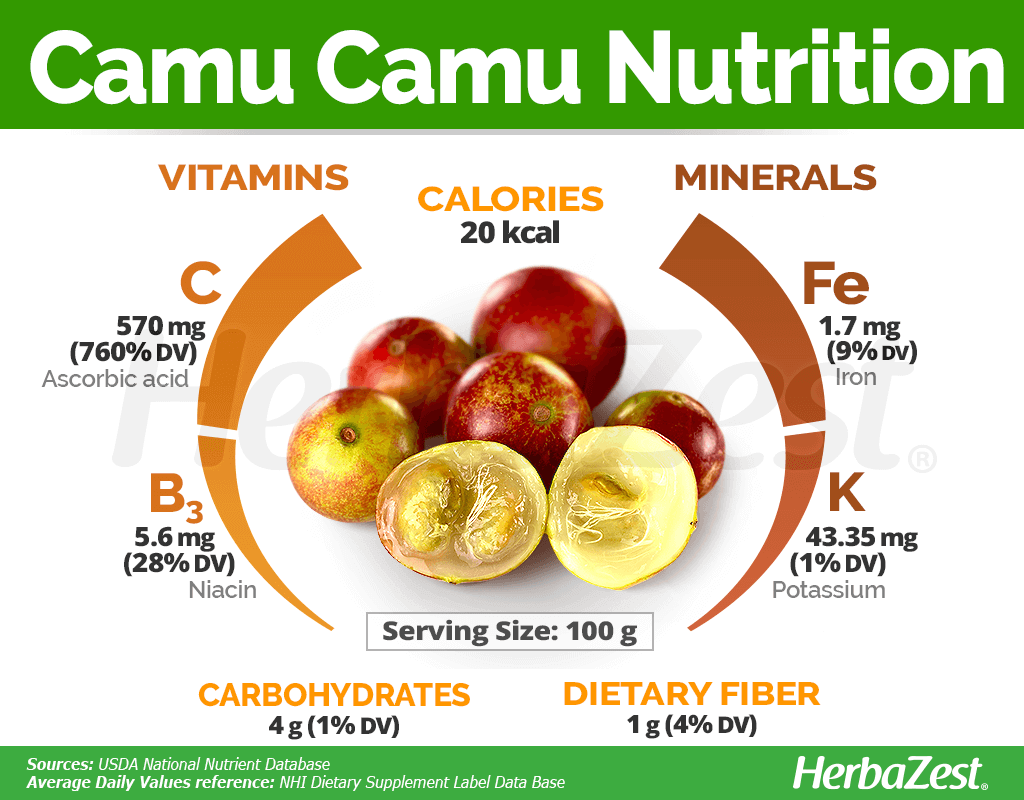
How to Consume Camu Camu
Outside of its native areas, camu camu fresh fruits, which have an intense, tart flavor, cannot be found in grocery stores. Whereas, this tropical superfood is widely available in the form of pure powder, which provides the ideal amount of nutrients per serving as a part of a healthy diet, and supplements, such as capsules and tablets, which come in convenient daily doses.
Natural Forms
- Frozen. The frozen camu camu juice with pulp is often diluted or mixed with other fruits, in order to reduce its tart flavor, due to its high amount of vitamin C.
Dried. As a healthy snack, although its vitamin C content is slightly reduced, dehydrated camu camu still offers a substantial source of essential nutrients.
- Powder. The dried and ground pulp of camu camu can be easily dissolved in juices and smoothies. In this form, camu camu provides all its nutritional, immune stimulant, and antioxidant properties.
Herbal Remedies & Supplements
Capsules. This widely preferred camu camu supplement carries a high concentration of nutrients and can be taken in easy to swallow, fixed daily doses in order to prevent colds and flu, as well for treating anemia and protecting eye health.
Herbal remedies of camu camu, such as syrup and tincture, while still provide antioxidant and anti-inflammatory benefits, are not the best sources of vitamin C since the herb's essential nutrients become degraded when exposed to heat.
- Edible parts Fruit
- Edible uses Flavoring, Beverage
- Taste Tart
Growing
Native to the tropical regions of Peru and Brazil, camu camu thrives in the riverbanks of the Amazon rainforest, but it can be adapted to hot subtropical climates.
This tropical species prefers warm, humid environments, and it requires plenty of water as well as full exposure to sunlight.
Useful camu camu growing guidelines can be found in the herb garden section.
- Life cycle Perennial
- Harvested parts Fruit
- Light requirements Full sun
- Soil Flooded
- Growing habitat Tropical rainforests, Amazon rainforest
- Plant spacing average 3 m (9.84 ft)
- Growing time Three years to bear fruit.
Additional Information
Plant Biology
Camu camu (Myrciaria dubia) is a dicotyledonous bush that grows alongside rivers in the Amazon rainforest in Peru and Brazil. It can range in height from 6 - 25 feet (2 - 7 m) depending on environmental conditions, and its evergreen leaves render its small clusters of fruit much more noticeable.
The camu camu tree contains small, sweet-smelling flowers that are white and waxy in texture. The plant also has a bushy, feathery foliage. Its leaves are lanceolate to elliptic, with individual leaves reaching up to 1.2--7.9 inches (3-20 cm) in length and 0.39—0.79 inches (1-2 cm) in width.
Classification
Camu camu is a member of the Myrtaceae family, which comprises about 140 genera and 3,000 species of trees and shrubs, widely distributed across tropical and subtropical regions. Well-known members of this family are allspice (Pimenta dioica), guava (Psidium guajava), and myrtle (Myrtus communis).
The genus Myrciaria comprises about 70 species of tropical American trees and shrubs, most of them native to the Amazon rainforest. Along with camu camu (M. dubia), notable members of this genus are jaboticaba (M. jaboticaba), blue grape (M. vexator), rumberry (M. floribunda), and cambui (M. tenella).
Varieties and Subspecies of Camu Camu
Since camu camu has been mostly grown in wilderness settings, agronomic and genetic studies have not yet been put in action, thus making it difficult to determine natural varieties. However, as long as the crop continues to gain importance economically, specific varieties and cultivars will likely start to appear.
Restricted natural habitat and the over-harvesting of natural areas have made it difficult for the camu camu plant to thrive, and subspecies of the plant are virtually nonexistent. Nascent commercial value and widespread reforestation efforts are working toward cultivation of a resilient, sustainable strain, but the trial and error process is still currently underway.
Historical Information
Members of various Amazonian tribes have used camu camu for medicinal purposes for hundreds of years. However, due to its sour, tart taste, it was rarely eaten in its raw form.
In the 1950s the Peruvian Ministry of Public Health took an interest in analyzing the fruit for more extensive urban consumption. Experiments resulted in enormous global interest, but its remote growth conditions made large-scale crop cultivation impossible until the 1990s. The plant has since been the subject of media interest surrounding deforestation and restorative efforts in South America, even as its commercial success grows.
Economic Data
Harvesting techniques that allowed for commercial exportation of camu camu may not have come about until the latter part of the 20th century, but countries that benefit from its wild growth have made up, economically, for that lost time.
Peru and Brazil are undoubtedly leading worldwide providers of the fruit, the former generating an estimated 71 tons in 2010; but such modest yields are more than made up for by the high price caused by its demand.
The U.S., which accounts for roughly half of the camu camu importation market, paid almost USD 7,200 per ton for its supply in the same year. Its high concentration of vitamin C is what make the plant so valuable today, and the main reason it has also been cropping up in the multivitamin industries of Japan and the U.S.
Other Uses of Camu Camu
As a natural beauty product, camu camu also has the ability to repair the split ends of hair while restoring its shine and strength. To this end, traditional practice has created a hair tonic from its juice for many years.
Sources
- American Macular Degeneration Foundation, Lutein for Preventing Macular Degeneration
- Another Boom for Amazonia?, p. 233
- Bioactives in Fruit: Health Benefits and Functional Foods
- Edible Medicinal and Non Medicinal Plants: Volume 3, Fruits, p. 633 – 634
- Florida's Best Herbs and Spices: Native and Exotic Plants Grown for Scent and Flavor, p. 165
- Food and Agriculture Organization (FAO), Corporate Ducument Repository, Camu-camu
- Food Chemistry, Antioxidant Compounds and Antioxidant Capacity of Peruvian Camu Camu [...], 2010 ; Carotenoid composition from the Brazilian tropical fruit [...], 2007
- Food Research International, Nutritional compositions and health promoting phytochemicals of camu-camu (Myrciaria dubia) fruit: A review, 2011
- Forests, Trees, and Livelihoods, The Cultivation of Camu Camu (Myrciaria dubia): A Tree Planting Program in the Peruvian Amazon, 2006
- Journal of Cardiology, Tropical fruit camu-camu (Myrciaria dubia) has anti-oxidative and anti-inflammatory properties, 2008
- Linus Pauling Institute, Vitamin C
- Natural Bioactive Compounds from Fruits and Vegetables as Health Promoters - Part 1, p. 249
- Oregon State University, Micronutrient Information Center, Manganese
- University of Hawaii, Myrtaceae
- University of Wisconsin, Myrciaria dubia, Camu Camu
- FAOSTAT, elected Species and Strategies to Enhance Income Generation from Amazonian Forests
- Journal of Agricultural and Food Chemistry, Determination of anthocyanins from camu-camu (Myrciaria dubia) by HPLC-PDA, HPLC-MS, and NMR, 2005
- Journal of Alternative and Complementary Medicine, Antioxidant and Associated Capacities of Camu Camu (Myrciaria dubia): A Systematic Review, 2015
- Anais da Academia Brasileira de Ciências, Effects of diet supplementation with Camu-camu (Myrciaria dubia HBK McVaugh) fruit in a rat model of diet-induced obesity, 2013
Footnotes:
- Journal of Cardiology. (2008). Tropical fruit camu-camu (Myrciaria dubia) has anti-oxidative and anti-inflammatory properties. Retrieved November 29, 2021 from https://www.journal-of-cardiology.com/article/S0914-5087(08)00150-0/pdf
- Data in Brief. (2017). Data on a single oral dose of camu camu (Myrciaria dubia) pericarp extract on flow-mediated vasodilation and blood pressure in young adult humans. Retrieved November 29, 2021 from https://www.ncbi.nlm.nih.gov/pmc/articles/PMC5752086/
